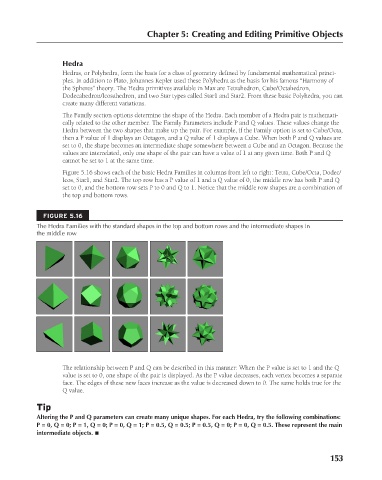Page 201 - Kitab3DsMax
P. 201
Chapter 5: Creating and Editing Primitive Objects
Hedra
Hedras, or Polyhedra, form the basis for a class of geometry defined by fundamental mathematical princi-
ples. In addition to Plato, Johannes Kepler used these Polyhedra as the basis for his famous “Harmony of
the Spheres” theory. The Hedra primitives available in Max are Tetrahedron, Cube/Octahedron,
Dodecahedron/Icosahedron, and two Star types called Star1 and Star2. From these basic Polyhedra, you can
create many different variations.
The Family section options determine the shape of the Hedra. Each member of a Hedra pair is mathemati-
cally related to the other member. The Family Parameters include P and Q values. These values change the
Hedra between the two shapes that make up the pair. For example, if the Family option is set to Cube/Octa,
then a P value of 1 displays an Octagon, and a Q value of 1 displays a Cube. When both P and Q values are
set to 0, the shape becomes an intermediate shape somewhere between a Cube and an Octagon. Because the
values are interrelated, only one shape of the pair can have a value of 1 at any given time. Both P and Q
cannot be set to 1 at the same time.
Figure 5.16 shows each of the basic Hedra Families in columns from left to right: Tetra, Cube/Octa, Dodec/
Icos, Star1, and Star2. The top row has a P value of 1 and a Q value of 0, the middle row has both P and Q
set to 0, and the bottom row sets P to 0 and Q to 1. Notice that the middle row shapes are a combination of
the top and bottom rows.
FIGURE 5.16
The Hedra Families with the standard shapes in the top and bottom rows and the intermediate shapes in
the middle row
The relationship between P and Q can be described in this manner: When the P value is set to 1 and the Q
value is set to 0, one shape of the pair is displayed. As the P value decreases, each vertex becomes a separate
face. The edges of these new faces increase as the value is decreased down to 0. The same holds true for the
Q value.
Tip
Altering the P and Q parameters can create many unique shapes. For each Hedra, try the following combinations:
P = 0, Q = 0; P = 1, Q = 0; P = 0, Q = 1; P = 0.5, Q = 0.5; P = 0.5, Q = 0; P = 0, Q = 0.5. These represent the main
intermediate objects. n
153
6/30/10 3:35 PM
11_617779-ch05.indd 153
11_617779-ch05.indd 153 6/30/10 3:35 PM

